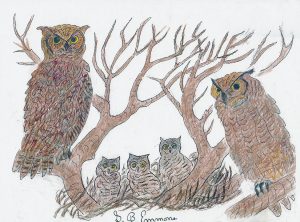This oversized monarch of the owl kingdom is the most dominant by observation and reputation in this country, although it is slightly smaller than the Eurasian eagle owl far across the pond.
Nevertheless, the great horned owl is big enough to challenge our national bald eagle when they clash over territorial domain. According to actual reports, the subsequent outcome can go either way, depending on which one gets the best grip on the other.
If there is the presence of a great horned owl near you, it may be heard in early evening, usually by four subsequent guttural hoots that, if translated into our language, may sound like “Hear me so near, to fear, and beware.”
The owl’s fearsome reputation ranks it as the only one to reportedly do-in a human being who was trying to rob its nest to captivate fledglings, the victim suffering mortal slashes from razor sharp talons. If this did happen, the nest would be guarded as in my illustration by both dedicated parents always on protective watch.
The female is always a constant dedicated matriarch, and the male a frequent arrival with sustenance of his latest kill including mammals, reptiles, bats, or other birds.
When aroused, they lean forward and lay back the tufts as well as the horns on their ears, like the devil himself, from which they get their name.
The dish-like expression and shape of their face that only a mother could love is purposely endowed by the Creator to catch even the slightest sound and funnel it to the extended ear sockets on either side of the head. They act like opposing range finders with an almost radar-like accuracy of a reflected signal blip. This permits an instant and accurate location of both distance and direction.
As their eyesight is poor and mainly fixed forward, the great horned owl can instantly turn its head from one side to the other, amazingly as much as 270 degrees for immediate direction and distant focus.
Unlike other diurnal hunters of the species that operate both day and night, this horned raptor can only function in darkness, to be rarely seen at all. If it should be still around briefly at daybreak, it may be found perched on an observation platform of a fence post at the edge of a clearing. This might be the expanses of cranberry bog clearings or searching Land Trust trails crossing fields, or hedgerows near convenient conifer coverts.
If temporarily exposed to the light of day, their perception is almost completely limited by capacity of audible over visual – the opposite of humans just getting out of bed.
As the dawning footlights of the coming day begin to raise the curtain of the morning’s orchestrated performance, the owl will soon move into the more comfortable shadows of his domain. Just as darkness is but a rotating shadow of the sun upon the face of mother Earth, this ending by the planetary shadow in the heavens will later lead a repeat of his domain, even for the nocturnal vision of a wise old great horned owl.
By George B. Emmons
